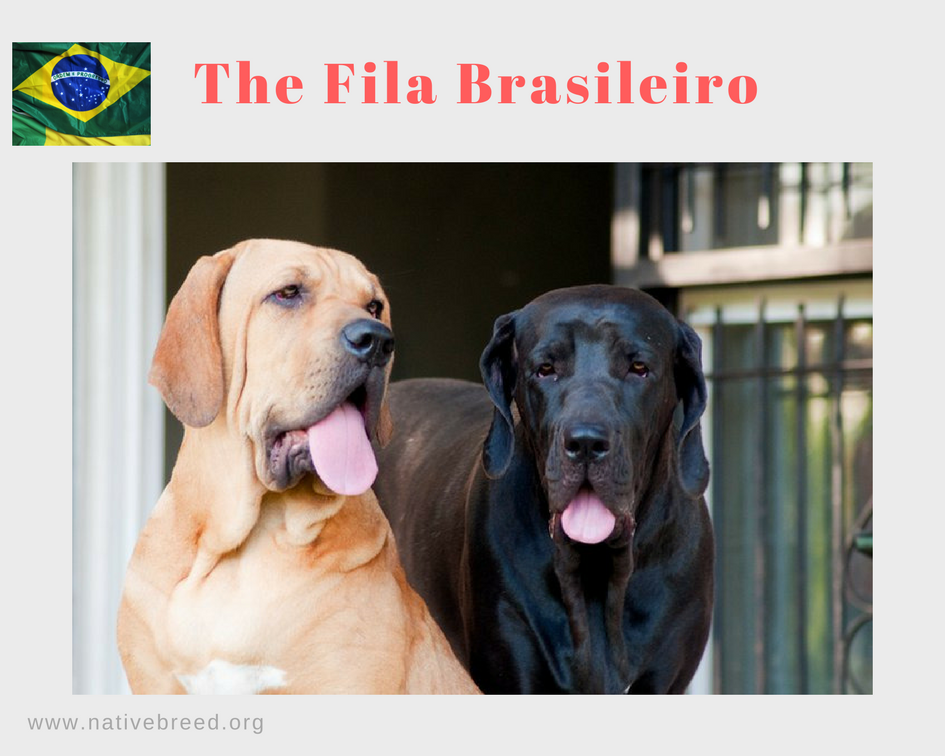The Fila Brasileiro, or Brazilian Mastiff, is a large working breed of dog developed in Brazil. It is known for its superb tracking ability, aggressiveness and an unforgiving, impetuous temperament. Rather than attacking its prey, the Fila traps it and waits for the hunter to arrive. Owing to these qualities, the Fila Brasileiro is used as a guard dog, as a cattle dog for livestock and as a hunting dog for tracking and controlling the large game. When slavery was legal in Brazil in the 18th century, the Fila Brasileiro was used to return fugitive slaves unharmed to their masters.
Appearance
In Brazil, the breed has two main standards imposed by two distinct clubs, the CBKC (Brazilian Confederation of Cynophilia) affiliated to FCI, and the CAFIB (Fila Brasileiro’s Enhancement Club). Consequently, the stock of each club has visible morphological differences. The CAFIB standard was constructed based on the ancient phenotype of the breed. But the current CBKC/FCI standard is the best known internationally.
The Fila Brasileiro is a molosser breed with large bones and loose skin. The FCI breed standard requires males to be between 65 and 75 cm (25.5 inches to 29.5 inches) high at the withers and weigh 50 to 82 kilograms (110 to 181 lb). Females are slightly smaller and are expected to be 60 to 70 cm (23.5 inches to 27.5 inches) high at the withers and weigh at least 41 kg (90 lbs). They have a rectangular build and though they are massive, their natural agility is apparent. The head is big and heavy with a deep muzzle. The ears are large, thick, tapered and either droop or fold back exposing the interior, depending on the dog’s mood. The neck and back are well muscled and the chest is broad and deep. Unlike the vast majority of canines, the croup is higher than the withers. The legs are heavily boned. The skin is very distinctive of the breed, as it is thick and loose all over the body, mainly in the region around the neck. The thick skin forms pronounced dewlaps. In many individuals, the dewlaps proceed to the chest and abdomen. Some dogs show a fold at the side of the head and also at the withers descending to the shoulders. The coat is short and dense and the texture is normally smooth and soft. Their colours vary from solid, brindle, mouse-grey, patched, dappled, or black and tan. They are almost never white. Typical colours are fawn, black and brindle. Brindles of a basic color may have the stripes of either less or with very strong intensity. Sometimes a black mask is present.
Though large in size, the Fila does not appear static. Rather it is harmonious, cat-like and, above all, powerful. The Fila appears self-assured and calm but is never absent in expression. When at attention, the gaze of the Fila Brasileiro is firm, alert and unwavering. Another typical characteristic of the breed is its gait, which is similar to that of a camel, moving two legs of one side at a time. The gait gives it a typical rolling lateral movement on the throat and the hindquarters which is accentuated when the dog’s tail is raised. The head is typically lower than the backline. The characteristic carriage and gait has earned it great success in dog shows.
The coat of the Fila Brasileiro is smooth and short. Black, fawns (red, apricot, or dark), and brindled (fawn, black, or brown brindle) colors are permitted, except mouse-grey, black and tan, blue, dappled and solid white. White markings, not exceeding 1/4 of the coat surface area, are permitted on the feet, the chest and the tip of the tail in the FCI standard.
The CAFIB standard does not accept black, mouse-grey, black and tan, blue, or dappled coats, as it considers them as a sign of crossbreeding; on the other hand, it accepts dogs with large white markings on any part of the body.
